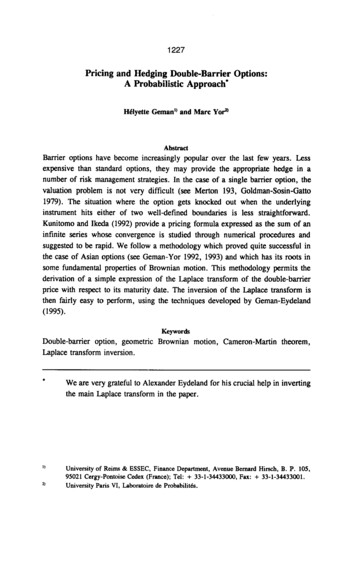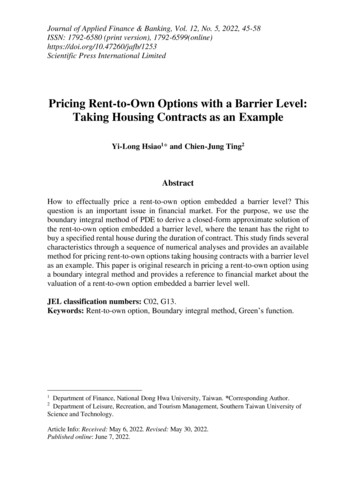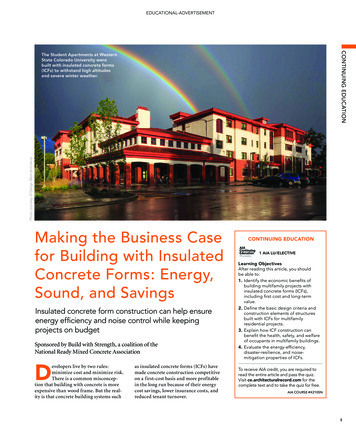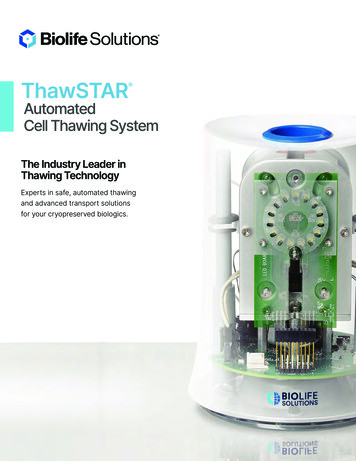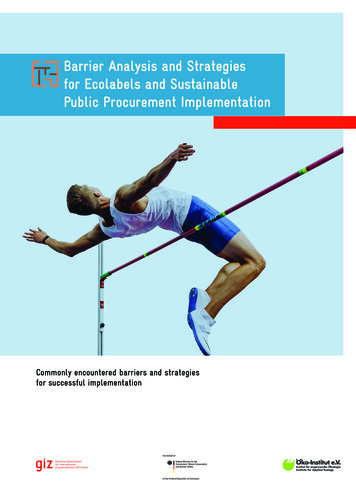
Transcription
Barrier Analysis and Strategiesfor Ecolabels and SustainablePublic Procurement ImplementationCommonly encountered barriers and strategiesfor successful implementation
As a federally owned enterprise, GIZ supports the German Government in achieving its objectives in the fieldof international cooperation for sustainable development.Published by:Deutsche Gesellschaft für Internationale Zusammenarbeit (GIZ) GmbHRegistered offices:Bonn and Eschborn, GermanyAuthors:Siddharth Prakash, Tobias Schleicher, Mirja MichalscheckÖko-Institut e.V.Editor:Kai HofmannDesign:The Ist Design Co., Ltd.Photo credit:www.123rf.comDistribution:Bangkok, November 2021GIZ is responsible for the content of this publication.ContactSiddharth PrakashSenior ResearcherDivision Products and Material FlowsÖko-Institut e.V.Postfach / P.O. Box 17 7179017 Freiburg. Deutschland / GermanyPhone: 49 761 45295-244Mobile: 49 160 907 970 35E-Mail: s.prakash@oeko.deWeb: www.oeko.deKai HofmannProject Director, Advance SustainableConsumption and Production (Advance SCP)Deutsche Gesellschaft für InternationaleZusammenarbeit (GIZ) GmbH193/63 Lake Rajada Office Complex, 16th Fl.,New Ratchadapisek Road, Klongtoey,Bangkok 10110, ThailandPhone 66 2661 9273E-Mail: kai.hofmann1@giz.dewww.giz.de
Table of ContentsList of derstanding ecolabels and SPP: Key conceptsUnderstanding ecolabels and SPP: Institutional set-up and stakeholdersUnderlining the role of ecolabels and SPP in the policy arenaUnderstanding underlying constraints towards a green or circular economy4.1 Externalized costs in unregulated markets4.2 The split incentive dilemma5 Barriers for Ecolabels5.15.25.35.45.55.65.7Insufficient domestic manufacturing sectorLimited impact of ecolabel as a sole measure“Chicken and egg” problemHigh certification costsMismatch with supplier branding strategyFast innovation cyclesNon-acceptance of non-state ecolabels6 Barriers for SPP6.16.26.36.46.5Insufficient support infrastructureUnclear reform mandateLeast (acquisition) cost paradigm in public procurement and capacity gaps of public procurersHigh upfront costs of sustainable productsIndustry policy focusing on domestic 53
List of FiguresFigure 1Figure 2Figure 3Figure 4Figure 5Figure 6Figure 7Figure 8Figure 9Figure 10Figure 11Classification of environmental labellingSPP landscape and governance: An exampleEU Product Policy FrameworkExample of Energy Saving Label in Japan(Dis)incentives for ecolabels on the supply and demand sideISO guiding principles for Type I ecolabels, irrespective of their ownershipExample showing linking SPP policies with high-level policy goalsBar chart illustrating the involvement of multiple institutions in the implementationof SPP policiesDecision making based on acquisition costs only often neglects other costs that arerelated to environmental impacts (e.g. high energy intensive operational costs)or waste disposalSector-specific business models such as Energy Performance Contracting (EPC)in the building sector can overcome the barrier of high upfront cost forgreen products and servicesIndustrial policy supporting SMEs can be linked to environmental policies suchas a circular and low carbon economy (including instruments such as SPP)BarrierSPPBarrierAnalysisAnalysis EcolabelsEcolabels && SPP4911151626374144475154
GlossaryEcolabel (Type 1)Seal demonstrating the environmental credentials of a product or service. A Type I ecolabel is a voluntary,multiple criteria-based, third party-run environmental label indicating overall environmental preferabilityof a product within a particular product category based on life cycle considerations. Type 1 ecolabels fulfilthe quality requirements of the ISO 14024.External effectsExternal effects are benefits and costs which arise when the social or economic activities of one actor (e.g. a company)have an impact on another actor (e.g. surrounding communities), which is not accounted for nor compensated.External costs (also negative externalities)External costs occur when producing or consuming a product or service imposes a cost upon a third party(e.g. the general public or future generations).Green Public Procurement (GPP)A process whereby public authorities seek to procure goods, services and works with a reducedenvironmental impact throughout their life cycle when compared to goods, services and works with thesame primary function that would otherwise be procured1.Life Cycle Assessment (LCA)Method for the assessment of environmental impacts of products over the whole life cycle, i.e. rawmaterial extraction, manufacturing, distribution, use and end-of-life. The methodological framework of LCAis specified by international standards ISO 14040/14044.Life Cycle Costing (LCC)Life cycle costing (LCC) is an assessment method including all costs related to the entire life cycle of a certainproduct. LCC thus includes not only purchasing costs (upfront costs) but also costs of installation, operation,maintenance and decommissioning.Life Cycle ThinkingLife cycle thinking involves applying approaches that consider implications of consumption and production ofproducts over their whole life cycle, i.e. raw material extraction for producing products, their manufacturing,distribution & transportation, use by consumers and disposal. In this way, life cycle thinking avoids“problem shifting from one life cycle stage to another, from one geographic area to another and from oneenvironmental medium to another”2.Sustainable Public Procurement (SPP)Sustainable Public Procurement (SPP) is generally understood to include environmental, economic and socialobjectives in the procurement of goods, services and works by public authorities.Start-UpA company in the first stages of operations, founded to develop a new product or service, generally startingwith high costs and limited revenue.Total costs of ownership (TCO)The total cost of ownership (TCO) examines all costs associated with purchased goods and services throughoutthe entire supply chain. Total costs of ownership are typically calculated by the LCC method.12European Commission (2014): What is GPP?; Available: https://ec.europa.eu/environment/gpp/what en.htm; Accessed: 16.12.2020UNEP (2005): Life Cycle Approaches - The road from analysis to practice, UNEP/ SETAC Life Cycle Initiative,Available: 4xPA-Road.pdf; Accessed: 16.12.2020BarrierSPPBarrierAnalysisAnalysis EcolabelsEcolabels && SPP5
AbbreviationsBATBest-Available TechnologyCCCCommon Core CriteriaEPCEnergy Performance ContractingEPDEnvironment Product DeclarationEUEuropean UnionCICapital InvestmentFSCForest Stewardship CouncilGDPGross Domestic ProductGENGlobal Ecolabelling NetworkGENICESGlobal Ecolabelling Network’s Internationally Coordinated Ecolabelling SystemGPPGreen Public ProcurementISOInternational Organisation for rofluorocarbonsLCCLife Cycle CostingLCALife Cycle AssessmentMEATMost Economically Advantageous TenderMRAMutual Recognition AgreementNGONon-Governmental OrganisationRAL gGmbHIndependent, non-profit private limited company responsible for checking compliancewith the requirements of Germany’s Blue Angel labelRERecurrent ExpenditureSCPSustainable Consumption and ProductionSDGSustainable Development GoalSEASoutheast AsiaSMESmall and Medium-Scale EnterprisesSOPStandard Operating ProceduresSPPSustainable Public ProcurementTCOThe Swedish Confederation of Professional EmployeesVATValue Added TaxWBCSDWorld Business Council for Sustainable DevelopmentBarrierSPPBarrierAnalysisAnalysis EcolabelsEcolabels && SPP6
IntroductionThe objective of ecolabels and Green or Sustainable Public Procurement (SPP)3is to influence consumption patterns to minimise the environmental damage caused by production of goods andservices. However, this objective is, in many cases, jeopardised by obstacles in their practical implementation.The existence of ecolabel criteria or a SPP policy alone does not guarantee the success and market penetrationof green products on an effective scale.Experience with establishing and institutionalising ecolabels and SPP policies in Southeast Asia (SEA) have revealedrepeatedly reoccurring barriers. Many of these barriers are relevant across countries and regions around the world.Thus, the experience gained in one country or region may be helpful to address similar barriers in other countries.The following compilation of common barriers contains a short description of each challenge and possible strategiesfor successfully overcoming these, including references to further information and best practices. The strategiespresented here are not exhaustive and originate from the authors’ practical experiences in the field of sustainableproduct policy frameworks.There is already a plethora of information and literature on best practices related to the implementation ofecolabels and SPP, for instance on the website of the UN One Planet Network4, the European Commission5 and theGlobal Ecolabelling Network (GEN)6. The authors therefore recommend visiting these knowledge platforms for moredetailed information and best-practice examples from around the world.3thetheareWe use the terms GPP and SPP interchangeably in this document. The term “Sustainable Public Procurement (SPP)” is being promoted byUN One Planet Network and includes environment, social and economic considerations in the procurement procedures. In other contexts,term Green Public Procurement (GPP) is used which entails environmental and economic considerations. In few cases, even social aspectsalso considered within the GPP approach.4 One Planet Network: Sustainable Public Procurement, c-procurement; Ecolabels: g-group-2-Type I-ecolabels; Accessed: 16.12.20205 European Commission: Green Public Procurement: https://ec.europa.eu/environment/gpp/eu gpp criteria en.htm; Accessed: 16.12.20206 Global Ecolabelling Network: https://globalecolabelling.net/; Accessed: 16.12.2020Barrier Analysis Ecolabels & SPP7
1Understanding ecolabels and SPP:Key conceptsThe basic concept of ecolabels and SPP relies on clear, verifiable,justifiable and ambitious environmental criteria for products andservices, based on life cycle thinking and a scientific evidence base.Before proceeding to the barriers and possible strategies, it is necessaryto clarify a few common concepts and terms: Type I, II & III labelling schemes:A Type I labelling scheme represents “a voluntary, multiple-criteria based, third party programme thatawards a license authorising the use of environmental labels on products indicating overall environmentalpreferability of a product within a particular product category based on life cycle considerations.”7 They arecommonly known as ecolabelling schemes, type I ecolabels, environmental label or simply ecolabels, theterminology used throughout this publication. Type I ecolabels must fulfil the quality requirements of theInternational Organisation for Standardisation (ISO) 14024:2018 (Environmental labels and declarations –Type I environmental labelling – Principles and procedures).Type II claims are based on self-declarations by manufacturers or retailers. An independent third-party verificationand certification is not required. ISO 14021 (Environmental labels and declarations – Self-declared environmentalclaims) specifies requirements for self-declared environmental claims, including statements, symbols and graphics,regarding products.Type III environmental labels are declarations that indicate the environmental impact of products and services ina quantitative manner over the life cycle of a product. They are commonly known as Environment ProductDeclarations (EPDs). They should be subject to independent checking and presented in a clear and comparableformat. Type III declarations are stipulated in ISO 14025 (Environmental labels and declarations – Type IIIenvironmental declarations – Principles and procedures).7 Global Ecolabelling Network: https://globalecolabelling.net/; Accessed: 16.12.2020Barrier Analysis Ecolabels & SPP8
Figure 1 - Classification of environmental labellingSource: Global Ecolabelling Network (2021); ng/; Accessed: 23.06.2021First-PartyEnvironment Labelling ProgramsThird-PartyEnvironment Labelling MarketingRecyclable) (e.g., “Proceeds (e.g., Companydonated to.”)Supports.)On ProductsorShelf LablesMandatoryPromotion ofCorporateEnvironmentalActivity orPerformanceHazard onProgramsInformationDisclosure(e.g., fueleconomy label)ReportCard(e.g., Type IIIEnv.Declaration)In AdsVoluntarySeal ofApproval(e.g., Type IEnv.Labelling)Single AttributeCertification(e.g., Energy Star) Voluntary instruments vs mandatory instruments:Ecolabels are by nature voluntary product-related instruments. However, many companies see a marketadvantage for ecolabelled products and certify some or all their products to target environment- and healthconscious consumers.SPP policies can be voluntary, mandatory or a mix of both. In some cases, SPP is mandatory at the nationalgovernment level, and voluntary for regional and local public authorities. In other cases, municipalities and citiescan also make SPP mandatory by passing corresponding local administrative laws. Furthermore, SPP policies couldalso be mandatory for certain priority product groups or for a single environmental or socio-economic issue”8.Ecolabels and, in many cases SPP, target products that are performing best in their product class. Ecolabelsnormally target 20-30% of the premium products and services in the market. In contrast, SPP may not always beable to target the best available products in order to be able to receive sufficient number of offers from potentialsuppliers. Nevertheless, SPP still has the ambition to promote innovation by targeting second-best options. Thus,usually SPP criteria are less ambitious than ecolabel criteria.An effective product environmental policy combines mandatory and voluntary instruments to drive innovations, fosterthe supply of sustainable products and forbid or discourage the supply of unsustainable products in the market. Anexample of a mandatory product instrument is the EU Ecodesign Directive, that aim to phase-out the worst-performingenergy-using and energy-related products from the market. In the absence of mandatory instruments, effectivenessof voluntary instruments may be limited (Refer to chapter 4.1 for discussion on voluntary & mandatory instruments).8 UNEP (2017): Global Review of Sustainable Public Procurement, 822/20919/GlobalReview Sust Procurement.pdf; Accessed: 16.12.2020Barrier Analysis Ecolabels & SPP9
Multiple-criteria vs single criteria labels:Type I ecolabels are multi-criteria labels, i.e. the criteria address several environmental aspects, such asgreenhouse gas (GHG) emissions, energy consumption, resource consumption, toxicity, waste generation, air,soil and water pollution and more. Of course, not all environmental aspects must be addressed. A life cycleassessment of products is used to identify the most important aspects. In a transparent, multi-stakeholderprocess, the focus of ecolabel criteria can be limited to the major environmental hotspots of a product.Single criteria labels address only one major environmental aspect of a product. For instance, the focus may beexclusively on energy consumption or GHG emissions. While the focus may express an important environmentaldimension, there may be significant trade-offs in the apparent best choice. For example, purely energy consumptionlabels for air-conditioners ignore the high global warming of certain refrigerants, such as hydrofluorocarbons (HFCs)and Hydrochlorofluorocarbons (HCFCs). Air-conditioners in Asian countries still rely heavily on HFCs and HCFCsas refrigerants. The most dominant refrigerant used in room air-conditioners is HCFC-22 with a Global WarmingPotential (GWP) of 1760. Global commitments to tackling the ozone depletion potential of HCFCs have led to anincreased use of HFCs. At the moment, a widely used alternative refrigerant to HCFC-22 is HFC-410a with a GWPof 1923.5 while few Asian countries have been opting for HFC-32 as an alternative refrigerant with a GWP of 677. Third-party award:Reliability of certification systems depends on their independence from the product manufacturersto preserve neutrality and impartiality. Type 1 ecolabels are awarded by an independent and unbiased third-partyorganisation and are therefore recognised as the most reliable certification schemes. This is a major differencefrom the type II labels (self-declarations of companies) and type III schemes (where conformity or critical reviewis done by an independent organisation which, however, is contracted by the manufacturer of the product). Self-declaration vs verification by independent third-party:Within the ecolabel and SPP schemes, compliance with the criteria can either be verified based on selfdeclaration (e.g. by manufacturers) or by requiring proof of independent third-party testing and confirmation(e.g. energy consumption threshold, measured and confirmed by a certified, third-party laboratory). Industryself-regulatory systems have limitations in terms of their acceptance in civil society and among consumers.In general, third party verifications should be preferred over self-declarations. At the most, self-declaration canbe used only in special cases to reduce the barriers for market access, for instance, for community-basedsmall organisations and SMEs. For instance, the self-declaration mechanism could be applied in a multi-yearumbrella contract for a few initial years of contract implementation, but then substituted by reliable,independent, third-party verification mechanisms. Life Cycle Approach:In the field of product policy, use of the term product life cycle is very common. This approach means that allphases of a product life cycle, i.e. raw material extraction, manufacturing of components and sub-components,final product assembly, transportation, use, reuse, recycling and end-of-life, should be considered for theoverall assessment of product environmental impacts and costs. Life Cycle Assessment (LCA) refers to theenvironmental assessment of a product over the whole life cycle, while Life Cycle Costing (LCC) refers to themethodology for calculating costs incurred by the product over the whole life cycle (e.g. purchase, maintenance,electricity, disposal costs).Barrier Analysis Ecolabels & SPP10
2Understanding ecolabels and SPP:Institutional set-up and stakeholdersAlthough there is ample literature on how ecolabels and SPP function, thereis little understanding in many countries of the institutional requirementsand participating stakeholders in ecolabels and SPP. Obviously, dependingon the context, institutional set-up and stakeholders differ acrosscountries. The following graphic (Figure 2) should help provide atheoretical understanding of key governance-mechanisms andstakeholders:Figure 2 - SPP landscape and governance: An exampleInstitutional Landscape of SPP stries2SPPTCLabellinginstitution31ConsumerB2B B2CManufacturersProduct Greening SPPSCTech.SpecsCentral Proc. AgencyOthersTSOffer 4Quality Infrastructure3rd party verificationBarrier Analysis Ecolabels & SPPM&V610Tender TS118SPPCriteriaSPPcertified /recognisedBranchAssoc.SPPPlanPlanning Ministry9Ministry of EnvironmentMinistryof IndustrySCPPlan Local or nat.ProcurementOffice
1. Manufacturers are the target groups of these reforms. They are required to change from producing ‘brown’ toproducing ‘green’ products.2. Ecolabelling Institution develops product-related criteria and establishes a third-party committee for ensuring theindependent verification before awarding the ecolabel. Such institutions can have various legal forms. Usually, theyare run by a public-sector institution that certifies products and services with an ecolabel. In few cases, ecolabellinginstitutions are also non-governmental organizations or private sector initiatives.3. Consumers with ecolabel awareness are critical for producer’s interest in certification. Since ecolabelled productstend to be more expensive, the consumers’ environmental awareness and their knowledge on ecolabel is essential.Different types of consumers are relevant: Private consumers, who purchase goods for the purpose of personal,family or household use, and organizational consumers, which consist of organizations, governments or businessesthat mostly buy in bulk, in many cases in a tendering process. Business consumers can also operate in purelybusiness-to-business purchases from pre-selected suppliers.4. Quality Infrastructure is essential for third party verification of product criteria. Quality infrastructure usually requiresaccreditation and calibrated testing instrument for various product groups.5. Planning Ministry, in SEA lead ministries develop top-level policies based on the SDGs, including DevelopmentPlans, SDG 12 (SCP) plans, road-maps or blue prints and at times SPP plans or road-maps, i.e. essential documentsto enable line-ministries to develop a legal framework.6. Line Ministries are mandated to develop the legislative documents, such as SPP policies. Often the Ministries ofEnvironment are mandated to develop these policies and green product criteria, while other line Ministries may bemandated to develop other sustainability criteria, e.g. social ones.7. GPP/SPP Technical Committees are platforms uniting relevant actors to negotiate SPP product criteria, often basedon market studies or other product information sources. In many cases, SPP Technical Committees are supported bya smaller ad-hoc core-group, including external product-specific experts to develop the actual criteria.8. GPP/SPP Certification or endorsement of products and services by Ministries or Central Procurement Agencies arepracticed in SEA to provide security to procurers. These products are often listed in online data-bases, directoriesand/or are marked.9. Central Procurement Agencies are generally procurer for the federal/ national government and responsible forpurchasing across ministries and ministerial departments. One of the main tasks is to bundle purchases and processthem centrally, which helps in saving funds of the federal budget. Central Procurement Agencies, in many cases, alsostandardize technical procurement requirement (e.g. standard technical specification, use of a type-I ecolabel as themeans of proof of compliance etc.), which could be a useful strategy for enabling SPP. Centralizing and standardizingprocurement procedures may also be helpful in establishing SPP monitoring systems.10. GPP/SPP Steering Committees are platforms uniting relevant public actors to advance and shape SPP policies.The chairmanship of the lead Ministry is often essential to create consensus among conflicting interests within thegovernment.11. Capacity Development by trainings, product catalogues or procurement circulars are often used in SEA to developthe trust and competencies of procurers to implement GPP/SPP.12. Tender processes using minimum green technical specification or green award criteria connect the procuring entitywith the green products. Often ecolabel (see 2) or SPP certificates or marks (see 3) are used to verify compliance.Barrier Analysis Ecolabels & SPP12
3Underlining the role of ecolabels and SPPin the policy arenaTotal governmental spending has a very high share of the nationalGross Domestic Product (GDP). Governments in countries like Cambodia,Myanmar, Vietnam, Thailand, Malaysia and Bhutan spend between 20and 40 % of the GDP. Thus, public procurement has a substantialeconomic and market power that creates a significant demand andshapes production. This market power and transformational potentialmake a strong case for embedding public procurement policies inhigh-level policy documents.However, the road from the integration in high-level policy documents to implementation on the ground is long.There are a series of procedures that need to be developed and substantiated to operationalise SPP and ecolabelseffectively. Furthermore, it is also extremely important to highlight the clear roles and responsibilities at the national,sub-national and municipality levels.A simplified hierarchy of policy documents in which SPP and ecolabels should be mentioned is provided below.1 High-level national planning documents, such as 5-year plans, socio-economic developmentplans, national development plans, national sustainability strategy, green deal;2 National roadmaps and action plans for key areas, such as Sustainable Consumption andProduction (SCP), green economy, circular economy;3 National legislation, such as climate change act, circular economy act, environmentprotection act;4 National Action Plan for SPP, including targets and key performance indicators, e.g. byasking for the percentage increase in the use of ecolabels in SPP tendering;5 Public procurement laws, regulations, bills and acts for implementing SPP at the national,sub-national and municipality level;6 Public procurement standard operating procedures (SoP) and circulars;7 Sector and product-specific guidelines, criteria, tender examples.Barrier Analysis Ecolabels & SPP13
4Understanding underlying constraintstowards a green or circular economyBefore proceeding to the specific barriers for SPP and ecolabelsand describing possible solutions, it is necessary to clarify someunderlying constraints that hinder the progress towards a Green orCircular Economy in general. Ultimately, ecolabels and SPP areaddressing the symptoms of a deeply rooted market-failure that haveallowed our take-make-dispose economy to continue.4.1 Externalized costs in unregulated marketsThe possibility to externalize costs to a third party and society in general (e.g. to future generations) in anunregulated market leads to an incentive to minimise private (marginal) costs (offer) and prices by manufacturers.External costs (also called externalities) are not part of the marginal costs of producers and suppliers (unregulatedoffer) and therefore lead to an incentive for higher resource use and environmental impacts compared to a situationin a regulated market that includes environmental legislation, regulations and functional compliance. Typical examplesfor externalities in the field of circular economy are situations in which waste, as an environmental externality, isunregulated. If, for example, hazardous waste is dumped into the environment, the environmental, social and healthcosts fire back in terms of polluted water and diseases in nearby communities. This means that one group (e.g.producers and users of products) can shift the burden of the waste to another group (e.g. local communities).Another typical example of a negative environmental externality is climate change itself as the costs do notoccur today but in the future (see “The Economics of Climate Change: The Stern Review, 2006”9). In this context, theexternality is intertemporal, meaning that the costs of the overconsumption today and its impacts are shifted to futuregenerations. All highly CO2 intensive economic activities in today’s mainly linear economies such as cementproduction for the building sector, CO2 emissions due to daily traffic or due to heating (in the North) and cooling(in the South) of buildings lead to high climate risks and costs in the future (increasing droughts, extreme heat orcold periods, rising sea water level, extreme loss of biodiversity, among others).Many policy measures need to be applied to internalize such external (and hidden) costs, i.e. to ensure that productsand services are sold at their “true prices” encompassing environmental and social costs (today and in the future).Examples include:9 7172811/http://www.hm-treasury.gov.uk/stern review report.htmBarrier Analysis Ecolabels & SPP14
Price increases for products, works or services that lead to pollution (e.g. CO2 tax, tax on primary resources, CO2emission certificates, removal of subsidies for environment polluting sectors), thus disincentivizing poor productionpractices; Price incentives for environment-friendly products (e.g. tax reduction for repairs and repair businesses, reduced leviesfor environment-friendly packaging, eco-innovation funds and subsidies for the development of environment-friendlyproducts); Implementing regulatory legislation that limits the negative impact of products effectively (e.g. minimum mandatoryecodesign standards, extended legal guarantees, extended producer responsibility); Decrease of subsidies that support polluting economic activities (e.g. subsidies on energy prices etc.) andcontribute to a stepwise internalization of externalities. Many countries subsidise polluting activities (e.g. Malaysiaand Thailand still have high subsidies on energy prices that make investments in energy efficiency measures lessprofitable). Examples from Germany and Europe are hard coal subsidies, subsidies for virgin plastics, aviation fueltax exemptions or agricultural subsidies by the EU.Voluntary labelling schemes per se do not have a large-scale direct market effect and hence, only have limitedpotential to effectively internalize externalities in the mass market. However, they need to be integrated in a mixof instruments within a product policy framework to achieve higher impact. Thus, they indirectly set standardsthat can be used for mandatory regulation in the future. F
Barrier Analysis Ecolabels & SPP Barrier Analysis Ecolabels & SPP 4 5 Figure 1 Classification of environmental labelling 9 Figure 2 SPP landscape and governance: An example 11 Figure 3 EU Product Policy Framework 15 Figure 4 Example of Energy Saving Label in Japan 16 Figure 5 (Dis)incentives for ecolabels on the supply and demand side 26 Figure 6 ISO guiding principles for Type I ecolabels .

